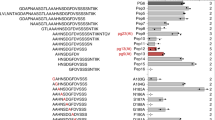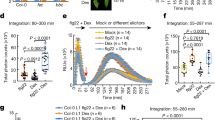Abstract
Plant diseases cause massive losses in agriculture. Increasing the natural defenses of plants may reduce the impact of phytopathogens on agricultural productivity. Pattern-recognition receptors (PRRs) detect microbes by recognizing conserved pathogen-associated molecular patterns (PAMPs)1,2,3. Although the overall importance of PAMP-triggered immunity for plant defense is established2,3, it has not been used to confer disease resistance in crops. We report that activity of a PRR is retained after its transfer between two plant families. Expression of EFR (ref. 4), a PRR from the cruciferous plant Arabidopsis thaliana, confers responsiveness to bacterial elongation factor Tu in the solanaceous plants Nicotiana benthamiana and tomato (Solanum lycopersicum), making them more resistant to a range of phytopathogenic bacteria from different genera. Our results in controlled laboratory conditions suggest that heterologous expression of PAMP recognition systems could be used to engineer broad-spectrum disease resistance to important bacterial pathogens, potentially enabling more durable and sustainable resistance in the field.
This is a preview of subscription content, access via your institution
Access options
Subscribe to this journal
Receive 12 print issues and online access
$209.00 per year
only $17.42 per issue
Buy this article
- Purchase on Springer Link
- Instant access to full article PDF
Prices may be subject to local taxes which are calculated during checkout




Similar content being viewed by others
References
Jones, J.D. & Dangl, J.L. The plant immune system. Nature 444, 323–329 (2006).
Zipfel, C. Early molecular events in PAMP-triggered immunity. Curr. Opin. Plant Biol. 12, 414–420 (2009).
Boller, T. & Felix, G. A renaissance of elicitors: perception of microbe-associated molecular patterns and danger signals by pattern-recognition receptors. Annu. Rev. Plant Biol. 60, 379–406 (2009).
Zipfel, C. et al. Perception of the bacterial PAMP EF-Tu by the receptor EFR restricts Agrobacterium-mediated transformation. Cell 125, 749–760 (2006).
Reaping the benefits: science and the sustainable intensification of global agriculture (RS Policy document 11/09) (Royal Society, London, 2009).
Hammond-Kosack, K.E. & Parker, J.E. Deciphering plant-pathogen communication: fresh perspectives for molecular resistance breeding. Curr. Opin. Biotechnol. 14, 177–193 (2003).
Gurr, S.J. & Rushton, P.J. Engineering plants with increased disease resistance: what are we going to express? Trends Biotechnol. 23, 275–282 (2005).
Leach, J.E., Vera Cruz, C.M., Bai, J. & Leung, H. Pathogen fitness penalty as a predictor of durability of disease resistance genes. Annu. Rev. Phytopathol. 39, 187–224 (2001).
McDonald, B.A. & Linde, C. Pathogen population genetics, evolutionary potential, and durable resistance. Annu. Rev. Phytopathol. 40, 349–379 (2002).
Zipfel, C. et al. Bacterial disease resistance in Arabidopsis through flagellin perception. Nature 428, 764–767 (2004).
Li, X. et al. Flagellin induces innate immunity in nonhost interactions that is suppressed by Pseudomonas syringae effectors. Proc. Natl. Acad. Sci. USA 102, 12990–12995 (2005).
Hann, D.R. & Rathjen, J.P. Early events in the pathogenicity of Pseudomonas syringae on Nicotiana benthamiana. Plant J. 49, 607–618 (2007).
de Torres, M. et al. Pseudomonas syringae effector AvrPtoB suppresses basal defence in Arabidopsis. Plant J. 47, 368–382 (2006).
Wan, J. et al. A LysM receptor-like kinase plays a critical role in chitin signaling and fungal resistance in Arabidopsis. Plant Cell 20, 471–481 (2008).
Miya, A. et al. CERK1, a LysM receptor kinase, is essential for chitin elicitor signaling in Arabidopsis. Proc. Natl. Acad. Sci. USA 104, 19613–19618 (2007).
Kaku, H. et al. Plant cells recognize chitin fragments for defense signaling through a plasma membrane receptor. Proc. Natl. Acad. Sci. USA 103, 11086–11091 (2006).
Gimenez-Ibanez, S. et al. AvrPtoB Targets the LysM receptor kinase CERK1 to promote bacterial virulence on plants. Curr. Biol. 19, 423–429 (2009).
Lee, S.-W. et al. A type I-secreted, sulfated peptide triggers XA21-mediated innate immunity. Science 326, 850–853 (2009).
Gimenez-Ibanez, S., Ntoukakis, V. & Rathjen, J. The LysM receptor kinase CERK1 mediates bacterial perception in Arabidopsis. Plant Signal. Behav. 4, 539–541 (2009).
Nekrasov, V. et al. Control of the pattern-recognition receptor EFR by an ER protein complex in plant immunity. EMBO J. 28, 3428–3438 (2009).
Wang, G.L., Song, W.Y., Ruan, D.L., Sideris, S. & Ronald, P.C. The cloned gene, Xa21, confers resistance to multiple Xanthomonas oryzae pv oryzae isolates in transgenic plants. Mol. Plant Microbe Interact. 9, 850–855 (1996).
Kunze, G. et al. The N terminus of bacterial elongation factor Tu elicits innate immunity in Arabidopsis plants. Plant Cell 16, 3496–3507 (2004).
Vinatzer, B. et al. The type III effector repertoire of Pseudomonas syringae pv. syringae B728a and its role in survival and disease on host and non-host plants. Mol. Microbiol. 62, 26–44 (2006).
Tai, T.H. et al. Expression of the Bs2 pepper gene confers resistance to bacterial spot disease in tomato. Proc. Natl. Acad. Sci. USA 96, 14153–14158 (1999).
Cui, H., Xiang, T. & Zhou, J.M. Plant immunity: a lesson from pathogenic bacterial effector proteins. Cell. Microbiol. 11, 1453–1461 (2009).
Xiang, T. et al. Pseudomonas syringae effector AvrPto blocks innate immunity by targeting receptor kinases. Curr. Biol. 18, 74–80 (2008).
Shan, L. et al. Bacterial effectors target the common signalling partner BAK1 to disrupt multiple MAMP receptor-signaling complexes and impede plant immunity. Cell Host Microbe 4, 17–27 (2008).
Gohre, V. et al. Plant pattern-recognition receptor FLS2 is directed for degradation by the bacterial ubiquitin ligase AvrPtoB. Curr. Biol. 18, 1824–1832 (2008).
Brun, H. et al. Quantitative resistance increases the durability of qualitative resistance to Leptosphaeria maculans in Brassica napus. New Phytol. 185, 285–299 (2010).
Fillatti, J.J., Kiser, J., Rose, R. & Comai, L. Efficient transfer of a glyphosate tolerance gene into tomato using a binary Agrobacterium tumefaciens vector. Bio/Technology 5, 726–730 (1987).
Horsch, R.B. et al. A simple and general method of transferring genes into plants. Science 227, 1229–1231 (1985).
German, A.M., Kandel-Kfir, M., Swarzberg, D., Matsevitz, T. & Granot, D. A rapid method for the analysis of zygosity in transgenic plants. Plant Sci. 164, 183–187 (2003).
Fradin, E.F. et al. Genetic dissection of Verticillium wilt resistance mediated by tomato Ve1. Plant Physiol. 150, 320–332 (2009).
Acknowledgements
We thank the John Innes Centre Horticultural Services for great plant care; D. Studholme (The Sainsbury Laboratory) for providing the EF-Tu sequence from X. campestris pv. musacearum 4381; S. Humphris, L. Pritchard, P. Birch and I. Toth (Scottish Crop Research Institute) for providing the EF-Tu sequences and extracts from Dickeya dianthicola 3534, P. atrosepticum 1043 and P. carotovorum 193; B. Vinatzer (Virginia Tech), J. Rathjen (The Sainsbury Laboratory) and S. Gelvin (Purdue University) for providing cultures of Pss B728a, Pta 11528 and A. tumefaciens A281, respectively; and S. Kamoun, E. Ward and J. Rathjen for their critical reading of the manuscript. This work was funded by the Two Blades Foundation and the Gatsby Charitable Foundation. B.P.H.J.T. is supported by a Vidi grant of the Research Council for Earth and Life Sciences of the Netherlands Organization for Scientific Research and by European Research Area Networks Plant Genomics. The Two Blades Foundation has filed a patent on behalf of inventors J.D.G.J. and C.Z. on the use of EFR to confer broad-spectrum disease resistance in plants.
Author information
Authors and Affiliations
Contributions
S.L., A.R.-C., E.S., N.P., D.D., H.P.E. and G.R. performed experiments and analyzed data. M.S. generated the transgenic plants. B.S. and B.P.H.J.T. contributed ideas, conceived experiments and analyzed data. J.D.G.J. initiated the project and contributed ideas. C.Z. initiated the project, conceived, designed and performed experiments, analyzed data, obtained funding, and wrote the manuscript. All authors commented on the manuscript prior to submission.
Corresponding author
Ethics declarations
Competing interests
The authors declare no competing financial interests.
Supplementary information
Supplementary Text and Figures
Supplementary Figures 1–5 (PDF 3678 kb)
Rights and permissions
About this article
Cite this article
Lacombe, S., Rougon-Cardoso, A., Sherwood, E. et al. Interfamily transfer of a plant pattern-recognition receptor confers broad-spectrum bacterial resistance. Nat Biotechnol 28, 365–369 (2010). https://doi.org/10.1038/nbt.1613
Received:
Accepted:
Published:
Issue Date:
DOI: https://doi.org/10.1038/nbt.1613
This article is cited by
-
Commensal lifestyle regulated by a negative feedback loop between Arabidopsis ROS and the bacterial T2SS
Nature Communications (2024)
-
Plant immunity research in China
Phytopathology Research (2023)
-
A Phytophthora receptor-like kinase regulates oospore development and can activate pattern-triggered plant immunity
Nature Communications (2023)
-
A recessive gene Cmpmr2F confers powdery mildew resistance in melon (Cucumis melo L.)
Theoretical and Applied Genetics (2023)
-
Transcriptome analysis reveals differential transcription in tomato (Solanum lycopersicum) following inoculation with Ralstonia solanacearum
Scientific Reports (2022)



